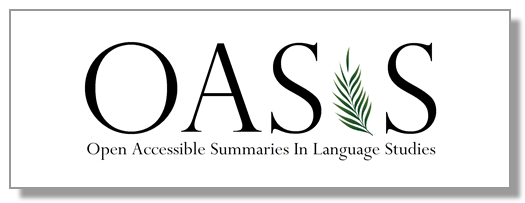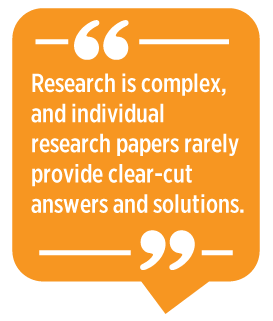|
 Research on language learning is prolific. A search
of the language and education sections on Web
of Science returns over 3.5 thousand articles for 2022 alone. Anyone
would have a job keeping up! Not only are there an abundance of articles, but
many of them are also lengthy, detailed, and filled with technical terms,
meaning they often take a lot of time to read. And that is if they are
available at all, as plenty of research findings disappear behind paywalls. It
is no surprise, then, that many teachers don’t engage directly with research
and research findings, even if they report that they are generally positive
toward research and think it can be useful (Marsden & Kasprowicz,
2017)—teachers are busy people! Research on language learning is prolific. A search
of the language and education sections on Web
of Science returns over 3.5 thousand articles for 2022 alone. Anyone
would have a job keeping up! Not only are there an abundance of articles, but
many of them are also lengthy, detailed, and filled with technical terms,
meaning they often take a lot of time to read. And that is if they are
available at all, as plenty of research findings disappear behind paywalls. It
is no surprise, then, that many teachers don’t engage directly with research
and research findings, even if they report that they are generally positive
toward research and think it can be useful (Marsden & Kasprowicz,
2017)—teachers are busy people!
OASIS: Accessible Research Summaries
During my PhD and as a postdoctoral researcher, I
have read through a mountain of research articles on multilingualism and
language learning. It could be a real slog and I had paid time to do it—a
luxury practitioners do not tend to have! In this article, I discuss one
initiative that tries to improve access to research findings for language
practitioners: Open
Accessible Summaries in Language Studies (OASIS). OASIS summaries are
one-page summaries written in nontechnical language. They are intended to
provide a 10-minute read that includes the information and detail needed to put
a study and its finding into some context. Each summary always includes the
following sections:
-
What the research was about and why it
is important: Here, the study is briefly explained and put into
context.
-
What the researcher(s) did:
In this section, the setup of the study is explained. Authors are encouraged to
include examples and to be specific about the participants and languages
involved.
-
What the researcher(s)
found: Here, the findings are reported in a format comprehensible to
nonspecialist readers, which includes avoiding detailed statistical
information.
-
Things to consider: This
section can be used to add nuance, relay concerns or particular takeaways, or
flag possible follow-up studies.
OASIS also includes a link to the original article
in case you want to know more and to any materials that are available online.
For example, this
summary about measuring oral proficiency contains links to the tests
they used.

OASIS was established in 2018 after a roundtable
with journal editors, with the support of professional organisations such as ACTFL
(in the United States) and the Association for Language Learning (ALL; in the
United Kingdom). The database is set up as a long-term, sustainable resource.
To achieve that, the organization works closely with academic journals in the
broad field of language studies. Some major international journals now ask
every author to write an accessible summary of their newly published articles,
which means OASIS constantly has new, up-to-date content on the database. One
of the journals they work with is TESOL Quarterly (TQ).
Every new article published in TQ has a corresponding
OASIS summary for you to read. Currently, there are more than 1,300 summaries
in the database, and all are freely available to download—with new ones being
added every week. See the Appendix for an example summary of an article about how to select vocabulary to teach published in TQ. (Download the original summary on OASIS here.)
Using OASIS for English Language Teacher Professional
Development
It is important to mention that OASIS does not give
direct recommendations of, for example, pedagogical choices. In other words,
they don’t tell you what to do. The main purpose of OASIS is to provide access
to research findings for people who might not otherwise have access or have
time to access. Research is complex, and individual research papers rarely
provide clear-cut answers and solutions. OASIS is therefore mainly meant as a
starting point for individual or group reflection and/or discussion.
 Here is a practical guide to how an English
language teacher could use OASIS summaries in their practice (adapted from Andringa
& Van Beuningen, 2020): Here is a practical guide to how an English
language teacher could use OASIS summaries in their practice (adapted from Andringa
& Van Beuningen, 2020):
Using OASIS to Reflect on Your Beliefs
and Intuitions
-
Think about a strong belief or intuition you
have about language learning or teaching (for example, Frequency-based
word lists are the most effective way of choosing what vocabulary to
teach). In a team, you could identify which
beliefs and intuitions exist and choose either the most common one or,
alternatively, choose a general theme for the different opinions that exist
within the team.
-
Identify key words (e.g., vocabulary, frequency, list) and use these to search the database for relevant
summaries. Currently, this search would return 94 summaries listed in order of
relevance.
-
Select the most relevant summaries based on the
details on the overview page. Details include the title
and information such as the type of learner, age
range, language being learned, and others. How
many you select depends on the time you have available and, if working in a
team, how many people are involved.
-
Read the selected summaries. If working in a team,
divide the work between team members. Take notes during reading, if
needed.
-
Reflect on what you’ve read. You can use these
questions to get you started:
-
Are the findings surprising? Why or why
not?
-
Do the findings change your thinking? Why or why
not? And in what way?
-
If the findings don’t change your thinking
entirely, do they add any side notes or caveats to your beliefs? If so, what
are they?
-
In what way do the insights gained from your OASIS
search have consequences for your teaching practice?
-
If working in a team, exchange the
insights each of you have gained from searching for and reading OASIS
summaries. If you have chosen to work around a specific theme for which there
were different perspectives, then first discuss for which perspective there was
most supporting evidence. Subsequently, reflect on what the insights mean for
your beliefs and practice (using, e.g., the questions in Step
5).
Variations
Here are some alternative starting
points:
-
Think of something in your practice that you or
your team find difficult to teach or would like to try a new approach for.
Together with your team, formulate a statement, such as "I would like
to know more about effective ways of giving feedback on oral presentations." Run through Steps 2–4 in the list, then note what inspiration you
have found from the materials, including possible caveats, like "has
only been tried with a different target audience." Use the information
you have read to create a classroom activity to use and evaluate. You can use
the following questions to guide your reflection:
-
As a teacher, did you like the approach? Why or
why not?
-
Did the students like the approach? Why or why
not?
-
Did creating or trying the new approach raise any
new questions?
-
If working in a team, were your and your
colleagues’ experiences with the new approach the same or not?
-
Think of something in your practice that you or
your team thinks works, but you’re not sure this is really the case or you’re
unsure why. Run through Steps 2–4 in the list and then reflect on your findings
using the following questions as a starting point:
-
To what extent does research show your approach
should work?
-
Did you find any studies that suggest your
approach is not the most effective one?
-
Can you explain any differences between your
experiences and research findings by looking at differences in, for example,
the target audience, the target language, etc.?
-
What did you find out regarding the
(in-)effectiveness of the approach?
-
Do the insights you’ve gained have consequences
for your teaching?
OASIS aims to give language practitioners agency by
providing access to research findings and letting you make up your mind about
what to take into your classroom. These are just some suggestions of how you
could use OASIS summaries to reflect on your practice and incorporate research
engagement in your routine.
NOTE: This article was written by an
OASIS employee.
*For more information, visit the OASIS
website. To stay up-to-date with any new content,
you can follow them on Twitter @OASIS_Database
or sign up for their automated weekly
digest of new summaries.
References
Andringa, S., & Van Beuningen, C. (2020).
Onderwijs ontmoet onderzoek. Vakwerk.
Marsden,
E., & Kasprowicz, R. (2017). Foreign language educators’ exposure to
research: Reported experiences, exposure via citations, and a proposal for
action. The Modern Language Journal, 101(4), 613–642. https://doi.org/10.1111/modl.12426OASIS
Summary
Inge
Alferink holds an MA in applied linguistics
and a PhD in linguistics. She currently works for OASIS as a project manager.
Inge is particularly interested in language learning and
multilingualism.
|